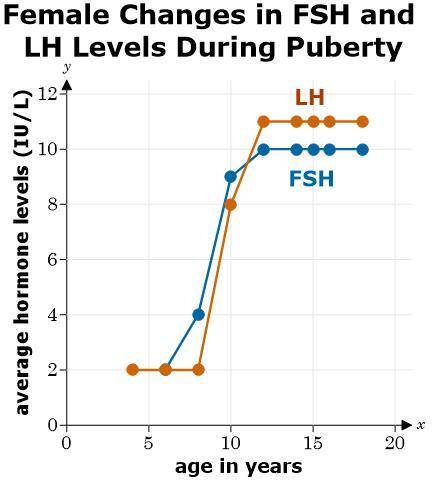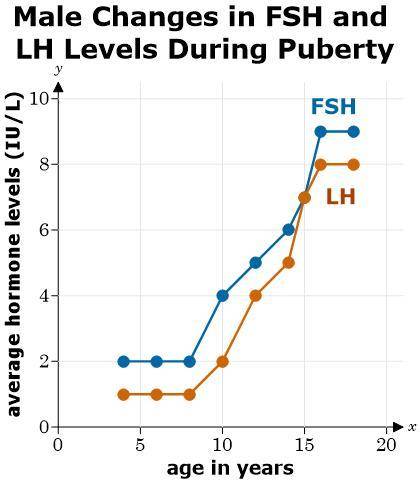
(for the A. P. Biology Reproduction and Development Quiz) A study of hormonal levels in males and females going through puberty was conducted. Levels of FSH and LH were measured from ages 2–18. Results are depicted in the following graphs:
Which answer describes a logical reason why LH and FSH were chosen for this study?
A. These hormones regulate gametogenesis and sex hormone production, so they play a pivotal role in puberty.
B. These hormones are only present in individuals undergoing puberty, so they provide a good indication of puberty.
C. These hormones directly cause puberty related changes.
D. These hormones are the only ones that fluctuate with puberty while other hormones are unchanged.
The graph indicates increases in both FSH and LH for males and females. However, male and female signs of puberty differ. Which of the following explains why?
A. Hormone levels increase for both of them, but LH levels increase more for males and less for females.
B. FSH and LH trigger higher testosterone production in males and higher estrogen production in females.
C. FSH and LH promote a positive feedback loop in females and a negative feedback look in males.
D. Reproductive systems of males and females have a different origin in development, and the cells within them therefore respond differently to the hormones.
If this data collection process was conducted on a daily basis, how would the data look different?
A. The male data would show daily drops in LH and FSH associated with food consumption.
B. The female data would show compensation for LH drops with increases in FSH and vice versa.
C. The male data would show higher levels of testosterone corresponding to lower levels of LH and FSH.
D. The female data would show monthly fluctuations of LH and FSH.



Answers: 3


Another question on Biology

Biology, 21.06.2019 23:00
The tasmanian devil, a marsupial carnivore, is facing extinction due to devil facial tumor disease (dftd) which causes bulging cancerous lumps and lesions to erupt around the face and neck — often causing enough deformation to make seeing or eating difficult. dftd has evolved into a contagious cancer, a trait that is unique among cancers. devil mating behavior involves biting around the head and neck, allowing cells from one individual — especially cells from the crumbly dftd tumors — to be transferred to the wounds or face of a new individual. this marsupial was once found across australia, but sea levels rose, isolating the tasmanian population, while the australian population went extinct. what would be an outcome of genetic isolation that is likely to have impacted the spread of dftd? a) reduced territory puts diseased individuals in greater contact with non-diseased ones. b) inbreeding results in less variation in facial features so the cancer is generally fatal. c) genetic isolation has made it difficult for scientists to develop a vaccine against dftd. d) the lack of genetic variation in the immune system of tasmanian devils minimizes resistance to the disease.
Answers: 3

Biology, 22.06.2019 06:00
When you run, you begin to breathe heavier and faster. your heart beats more quickly, bringing more oxygen to your cells. which organ systems are working together here?
Answers: 1

Biology, 22.06.2019 07:30
Directions: read the descriptions of the four islands presented in the lesson. 1. list two new traits that each new species of rat might demonstrate as it adapts to the conditions on each island. 2. introduce one of the four new rat species to another island and describe one challenge it would encounter and one success as it adapts to its new environment.
Answers: 2

Biology, 22.06.2019 07:30
The ancestors of plants that lived in water had plenty of water for the young. angiosperms are a group of land plants that evolved a reproductive trait for living on land. this trait protect young plants by allowing them to grow only when water is present and the conditions for healthy development are right. what trait most likely young angiosperms in this way?
Answers: 1
You know the right answer?
(for the A. P. Biology Reproduction and Development Quiz) A study of hormonal levels in males and fe...
Questions

Geography, 25.03.2020 22:34




Mathematics, 25.03.2020 22:34

Mathematics, 25.03.2020 22:34

Advanced Placement (AP), 25.03.2020 22:34


Mathematics, 25.03.2020 22:34







Chemistry, 25.03.2020 22:35


Mathematics, 25.03.2020 22:35





